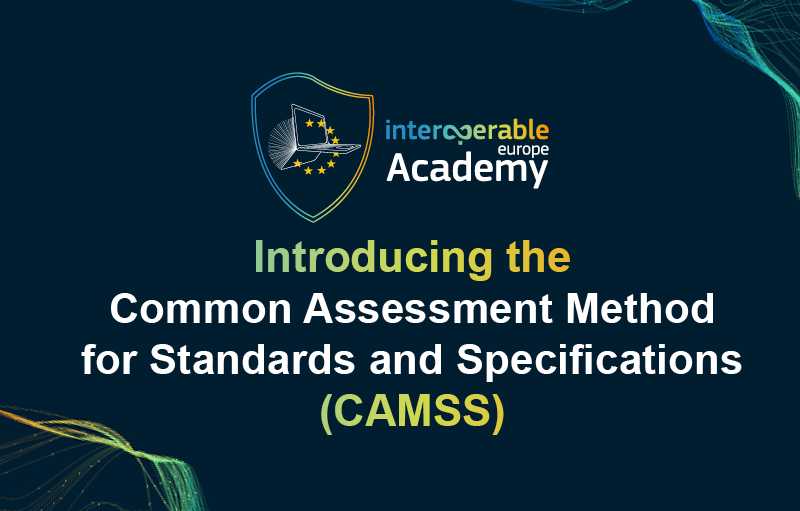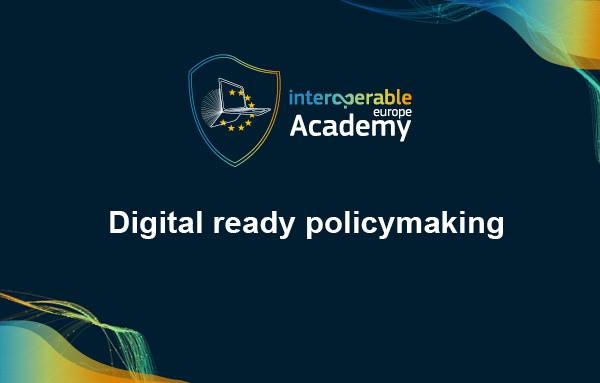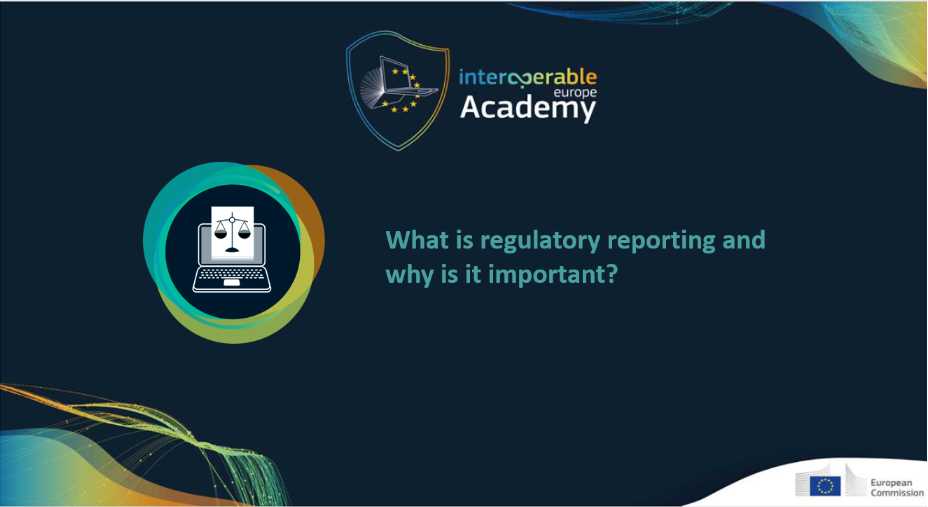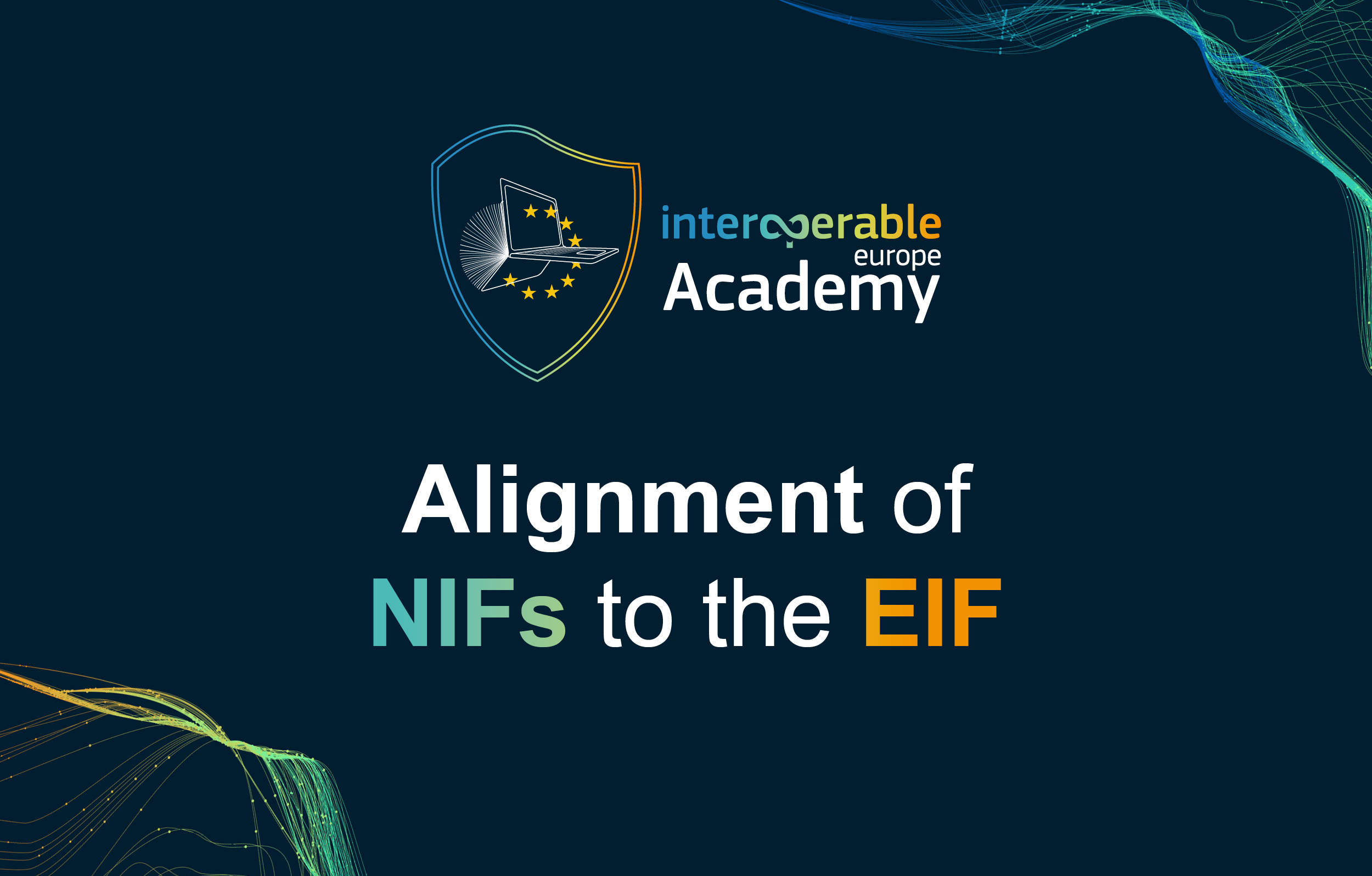Welcome to the Interoperable Europe Academy eLearning. This is a dedicated space for courses that will help you boost your advanced digital skills in the area of interoperability in the public sector.
The courses are meant for everyone interested in interoperability, but specially targeted to public servants engaged in digital transformation in order to support policy, service delivery and impact evaluation. Of course, all interoperability enthusiasts are welcome!

01. Interoperable Europe Act: Introduction
This short course will provide an introduction to the Interoperable Europe Act for public servants across Europe, including the background and context, why the Act is needed, how it links with other EU digital policies, legislation and the 2030 Digital Decade targets. The course will also provide insight into what is regulated, who is affected and demonstrate the key features of the Act. It will also highlight the involvement for public sector authorities in terms of planning and monitoring.
Click here to go the course.

02. Big Data Test Infrastructure: Enabling a data-informed public sector
The main objective of the Big Data Testing Infrastructure (BDTI) eLearning course is to support EU public administrations in moving forward with data literacy and developing data analytics pilots, free of charge, using the open source tools offered by the BDTI infrastructure.
Click here to go the course.

03. The Once Only Technical System
This eLearning course introduces the Once-Only Technical System which lets EU public authorities securely exchange official documents and data at the request of citizens and businesses as part of cross-border administrative procedures. The course will provide context, background and definitions of the Once Only Technical System, with further sections examining the user journey, components and architecture, and things to think about when putting it into practice in cross-border public services. It will also provide an overview of supporting tools and services and a knowledge test.
Click here to go the course.

04. Introducing the Common Assessment Method for Standards and Specifications (CAMSS)
This eLearning course introduces the Common Assessment Method for Standards and Specifications (CAMSS), an action for assessing standards and specifications and helping its inclusion within eGovernment projects. The main objective of CAMSS is achieving interoperability and avoiding vendor lock-in by establishing a neutral and unbiased method for the assessment of technical specifications and standards in the field of ICT. This method is compliant with the Regulation 1025/2012 on European Standardisation and the European Interoperability Framework (EIF).

05. Introduction to Artificial Intelligence for Public Service Interoperability
As AI models become more and more powerful in linking data together and extracting and linking it based on its semantics, different methods and approaches have been proposed to apply AI to support interoperability. At the same time, different proposed approaches have shown that interoperability can support AI by providing data that is of assessed quality. This course will provide an introduction to the fundamentals of AI for interoperable public services, covering the concept of Artificial Intelligence, and its components, the legal and policy contexts, methods to support interoperability through AI, challenges and example applications.
Click here to go the course.

06. Interoperability: an introductory course
This course provides a solid understanding about interoperability, including the need for it, the interoperability environment at high level and the respective initiatives of the European Commission. The course also gives insights on the opportunities that can be leveraged to identify the appropriate interoperability modules for the implementation of the services reusing existing interoperable solutions.
Click here to go to the course.

07. The European Union Public License (EUPL)
This course will provide a background to the European Union Public Licence (EUPL) and the value it can add to interoperable public services. It will provide a recap on the nature and history of the European Union Public Licence: why the EUPL was created, the additional provisions and features that make the EUPL specific and the EUPL scope in relation to how software can be distributed. It will also examine how some of the key concepts of open licensing, such as Reciprocity, Interoperability and Compatibility relate to the framework of the EUPL. The course will end with a quiz to assess your knowledge, followed by a certificate of completion.
Click here to go to the course.

08. Introduction to Open Software Licenses
This course aims to provide a solid understanding about software licensing and license types, before looking in detail at open license types, their benefits and how they contribute to software and data interoperability.
Click here to go to the course.

09. Joinup Licensing Assistance
The aim of this course is to provide a solid understanding about Licensing and the added-value provided by the Joinup Licensing Assistant in this regard in order to support the target audience to define the conditions under which a certain solution may be freely shared and reused. In order to do that, the course covers the below four topics: Overview: Open licensing in general; Key Components of Joinup Licensing Assistant; Demonstration of the Joinup Licensing Assistant (JLA) and practical information; Assessment.
Click here to go to the course.

10. Understanding Law as Code
Law as Code, or the idea that governments ought to develop an official version of legal texts that can be consumed by machines, has become a matter of interest in policymaking and academic circles. This course will introduce the Law as Code concept, underlining its potential whilst also presenting the challenges that need to be overcome for successful implementation. Among other things, participants will explore the importance of semantics in Law as Code applications, delve into implementation approaches, tools, and resources, and consider the legal and ethical principles that ought to guide the use of such systems.
Click here to go to the course.

11. Digital ready policymaking
Digital-ready policymaking is one of the aspects of the European Commission's Better Regulation Agenda, aiming to adjust the policies to fit the needs of the digital age. To bridge the gap between drafting legal texts and implementation thereof, the Legal Interoperability team prepared a Toolbox on Digital-ready policymaking, explaining how policymakers can use digital technology and data in their policies. This course will introduce you to the major components of digital-ready policymaking and give some practical examples of how they are implemented across Europe.
Click here to go to the course.

12. What is regulatory reporting and why is it important?
Regulatory reporting is an integral part of ensuring the implementation of EU legislation and has significant impacts on the policy cycle. Nonetheless, this process faces persistent problems, such as the multiplication of reporting requirements in legislation and the complexity of new technologies. Hence, this online course examines what regulatory reporting is and its importance. It also highlights the benefits of streamlining this process and the principles that could gradually change regulatory reporting practices. Considering the importance of the topic of developing better legislation for smoother implementation (BLSI), this course is part of the BLSI learning path. Thus, we encourage you to take our short introductory course first.
Click here to go to the course.

13. European Interoperability Framework
The course raises awareness around the importance of interoperability for the delivery of integrated public services. For doing so, it presents the European Interoperability Framework (EIF).
Click here to go to the course.

14. Alignment of the National Interoperability Frameworks (NIFs) to the European Interoperability Framework (EIF)
The course is designed to equip national public administrations with the knowledge, skills and tools necessary to align their national interoperability frameworks (NIFs) with the European Interoperability Framework (EIF) in order to promote interoperability at national and European level.
Click here to go to the course.

15. The EIF Toolbox, support and guidance for the implementation of the EIF
The course will give users an opportunity to learn about the EIF toolbox, a solution with a holistic approach which was designed to equip national public administrations with all the necessary tools so that they can align their National Interoperability Frameworks with the European Interoperability Framework and promote interoperability at national and European level. Through the course, users will gain access to the EIF Toolbox’s guidance documents on the theoretical background of the framework (EIF Pillars), and the operational solutions covering the alignment and implementation aspects of this exercise. The EIF toolbox is a dynamic solution that will evolve over time emphasizing on practical success implementation stories, thus bridging the gap between public administrations and interoperable digital public services.
Click here to go to the course.
16. Introduction to core vocabularies
This video presentation describes the objectives of a set of Core Vocabularies that can be used to describe common entities like persons and places and includes testimonials from implementers in two cities (Ghent in Belgium and Bordeaux in France) on how common definitions can create interoperability in data exchange. After completing the course, the learner is expected to have a good understanding about the fundamental principles of Core Vocabularies and how they can be used in practice.
Click here to go to the course.

17. Access to Base Registries
The Access to Base Registries (ABR) eLearning course will help you understand the aim of the ABR action, learn more about the BRegDACT-AP specification and why you should use it, as well as how to implement it. The course offers an overview of the main concepts supported with practical examples which will help the learner to better grasp the topic and become able to implement it in their daily life.
Click here to go to the course.

18. Core Public Service Application Profile (CPSV-AP) introduction
What is CPSV-AP ? Why should I use it ? How can I use it ? These are the key questions the participants will be expected to answer after completing this course. Participants will have the opportunity to become familiar with the CPSV-AP specification and understand what benefits can be derived from its implementation. At the end of this course, participants will be able to facilitate the implementation of CPSV-AP via the main theoretical concepts conveyed throughout the course but also to be able to apply them into practice, thanks to the exercises and tests provided in the course.
Click here to go to the course.

19. Publishing data with Linked Data Event Streams why and how
Different public administrations started publishing Linked Data Event Streams as the core API of their publishing strategy. This allows third parties to replicate the full Linked Data dataset and keep it in sync afterwards. However, that is not where it stops: it bootstraps an ecosystem of reusable indexes on top of the main event stream. In this course you will learn how to use LDES as a way to prioritize Web API features for your data publishing strategy. Next, we will deep-dive into the LDES and TREE specifications theoretically and understand what they allow. Then we will learn from three existing implementations how they turned their existing data publishing into a Linked Data Event Stream, and finally, we will show how you can reuse these new Web APIs as a data consumer.
Click here to go to the course.

20. Wikibase and Semantic MediaWiki for data-driven semantics
In this course, you will learn how community-led tools and platforms like Wikibase, Semantic MediaWiki, and Wikidata can be used to create a data-driven semantic layer in a bottom-up way. Data-driven projects are not meant to replace traditional semantics, typically implemented in a more top-down manner with ontologies and controlled vocabularies carefully designed by official institutions and experts, but rather to offer an alternative and complementary approach leveraging the power of distributed knowledge to improve linked data solutions.
Click here to go to the course.

21. IMAPS introduction
This eLearning has for objective to enable current and future IMAPS users to understand what the IMAPS solution is about and how IMAPS can support public administrations in improving their digital public services towards seamless interoperability. This first module starts by positioning IMAPS in the context of the European Interoperability Framework. The users will then discover the concept of IMAPS, target users in public administrations and different use cases. The criteria for selecting a digital public service for an IMAPS assessment will be explained, as well as the different types of digital public services, which can be assessed with IMAPS. Finally, the course will present IMAPS success stories which illustrate how IMAPS can assist public administrations in improving the interoperability of digital public services. Upon the completion of this course, the user will have acquired basic knowledge for being able to start his/ her own IMAPS assessment of a digital public service.
Click here to go to the course.

22. IMAPS in practice
This eLearning has for objective to enable current and future IMAPS users to understand what the IMAPS solution is about and how IMAPS can support public administrations in improving their digital public services towards seamless interoperability. This second module shows how the IMAPS assessment works in practice by introducing a concrete case of a digital public service, i.e. an online tax declaration service provided by a public administration. It explains how to select and scope a digital public service for the IMAPS assessment. Moreover, it navigates current and future users through the different sections of the IMAPS questionnaire. The IMAPS users will discover example questions on key interoperability enablers for the three services areas included in the IMAPS assessment. Finally, a preview is given on the final results with the IMAPS interoperability score and recommendations.
Click here to go to the course.

23. PM C1 - PM² Essentials, Project Management Methodology
This course provides a summary of the PM² Methodology developed by the European Commission, to enable Project Managers deliver solutions and benefits to their organisations by effectively managing projects. The aim of the course is to provide learners with an overall understanding of the roles and responsibilities in project management. This e-learning module consists of: Content module: Including video animations, action cards and short quizzes. Assessment module: Including 20 questions with a pass mark of 60%.
Click here to go to the course.

24. PM A1-PM²-Agile Essentials
This course has been designed for anyone interested in learning and/or adopting Agile practices. The course consists of the following content modules: About Agile, PM²-Agile overview, PM²-Agile roles and responsibilities, PM²-Agile themes, PM²-Agile ceremonies, PM²-Agile Artefacts, PM²-Agile Tools & Techniques, Summary. Before undertaking this course, please ensure that you have successfully completed the: PM C1 - PM² Essentials, Project Management Methodology.
Click here to go to the course.

25. Enabling the Twin Digital and Green Transition via Solid and Internet of Things
Welcome to this “Enabling the Twin Digital and Green Transition via Solid and Internet of Things (IoT)” training course. This training provides a context on the use and sharing of citizen generated data streams, how it can impact DG Environment’s mandate to protect the environment and how Solid technology can be demonstrated with a custom developed proof of concept.
Click here to go to the course.

26. Interoperability Test Bed: conformance testing for managers
The course is designed to equip project managers across a range of organisations such as national public administrations, international organisations and NGOs, with the knowledge and skills necessary to implement conformance and interoperability systems testing for semantic and technical aspects using the Interoperability Test Bed, and to put in place appropriate tools and resources.
Click here to go to the course.

27. Getting started with the Interoperability Test Bed
The course is designed to offer knowledge and skills necessary to implement conformance and interoperability systems testing for semantic and technical aspects using the Interoperability Test Bed, and to put in place appropriate tools and resources. The Interoperability Test Bed is a service offered by the European Commission. The Test Bed is a software that can be downloaded and installed locally, but also reused through a shared online installation operated by the Commission. It offers an intuitive web user interface that allows administrators to define their project’s overall testing setup as well as users to run tests.
Click here to go the course.
28. Introduction to the European Interoperability Reference Architecture: part 1
The course will provide an introduction and orientation to the European Interoperability Reference Architecture: part 1(EIRA) for policy officers, business analysts and legal advisors, who collaborate with solution architects and contribute to the design on new interoperable public services. It will exemplify problem definition and look at analysis of requirements, before exemplifying with use cases. This is an introduction course that does not require specific previous knowledge for enterprise architectures and will be followed by more advanced courses, with the following courses looking in more detail at developing specific solutions.
Click here to go the course.

29. Introduction to the European Interoperability Reference Architecture: part 2
EIRA is an architecture content metamodel defining the architectural building blocks (ABBs) needed to build interoperable e-Government systems. The EIRA provides a common terminology that can be used by people working for public administrations in various architecture and system development tasks. This course aims at providing an analytical description of the EIRA views focusing on the details of the EIRA technical view and providing specific concrete examples.
Click here to go the course.

30. Introduction to the Core Public Service Vocabulary Application Profile (CPSV-AP)
What is CPSV-AP ? Why should I use it ? How can I use it ? These are the key questions the participants will be expected to answer after completing this course. Participants will have the opportunity to become familiar with the CPSV-AP specification and understand what benefits can be derived from its implementation. At the end of this course, participants will be able to facilitate the implementation of CPSV-AP via the main theoretical concepts conveyed throughout the course but also to be able to apply them into practice, thanks to the exercises and tests provided in the course.
Click here to go the course.

